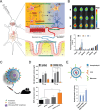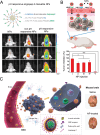Brain Targeting Nanomedicines: Pitfalls and Promise
- PMID: 38828195
- PMCID: PMC11143448
- DOI: 10.2147/IJN.S454553
Brain Targeting Nanomedicines: Pitfalls and Promise
Abstract
Brain diseases are the most devastating problem among the world's increasingly aging population, and the number of patients with neurological diseases is expected to increase in the future. Although methods for delivering drugs to the brain have advanced significantly, none of these approaches provide satisfactory results for the treatment of brain diseases. This remains a challenge due to the unique anatomy and physiology of the brain, including tight regulation and limited access of substances across the blood-brain barrier. Nanoparticles are considered an ideal drug delivery system to hard-to-reach organs such as the brain. The development of new drugs and new nanomaterial-based brain treatments has opened various opportunities for scientists to develop brain-specific delivery systems that could improve treatment outcomes for patients with brain disorders such as Alzheimer's disease, Parkinson's disease, stroke and brain tumors. In this review, we discuss noteworthy literature that examines recent developments in brain-targeted nanomedicines used in the treatment of neurological diseases.
Keywords: blood-brain barrier; brain delivery; cancer; nanoparticle; neurodegenerative diseases; stroke; targeted delivery.
© 2024 Kakinen et al.
Conflict of interest statement
Mart Saarma (MS) is the founder and a shareholder in Herantis Pharma Plc. that develops PD drugs. MS is also a shareholder in Nanoform Plc that develops new nanotechnologies. Tambet Teesalu is an inventor on patents on CendR peptides and a shareholder of Lisata Therapeutics, a company that develops tumor-penetrating CendR peptides for cancer therapy. The authors report no other conflicts of interest in this work.
Figures





Similar articles
-
Advances in nanomedicine for the treatment of Alzheimer's and Parkinson's diseases.Nanomedicine (Lond). 2016 May;11(10):1267-85. doi: 10.2217/nnm-2016-0019. Epub 2016 Apr 14. Nanomedicine (Lond). 2016. PMID: 27077453 Review.
-
Nanoparticle-Based Technology Approaches to the Management of Neurological Disorders.Int J Mol Sci. 2020 Aug 23;21(17):6070. doi: 10.3390/ijms21176070. Int J Mol Sci. 2020. PMID: 32842530 Free PMC article. Review.
-
Nanoparticles for Targeted Brain Drug Delivery: What Do We Know?Int J Mol Sci. 2021 Oct 28;22(21):11654. doi: 10.3390/ijms222111654. Int J Mol Sci. 2021. PMID: 34769082 Free PMC article. Review.
-
Targeting Brain Tumors with Nanomedicines: Overcoming Blood Brain Barrier Challenges.Curr Clin Pharmacol. 2018;13(2):110-119. doi: 10.2174/1574884713666180412150153. Curr Clin Pharmacol. 2018. PMID: 29651960 Review.
-
The Therapeutic Benefits of Intravenously Administrated Nanoparticles in Stroke and Age-related Neurodegenerative Diseases.Curr Pharm Des. 2022;28(24):1985-2000. doi: 10.2174/1381612828666220608093639. Curr Pharm Des. 2022. PMID: 35676838
Cited by
-
Drug Delivery Across the Blood-Brain Barrier: A New Strategy for the Treatment of Neurological Diseases.Pharmaceutics. 2024 Dec 19;16(12):1611. doi: 10.3390/pharmaceutics16121611. Pharmaceutics. 2024. PMID: 39771589 Free PMC article. Review.
-
Precision Neuro-Oncology in Glioblastoma: AI-Guided CRISPR Editing and Real-Time Multi-Omics for Genomic Brain Surgery.Int J Mol Sci. 2025 Jul 30;26(15):7364. doi: 10.3390/ijms26157364. Int J Mol Sci. 2025. PMID: 40806492 Free PMC article. Review.
-
Role of Nanomedicine in Transforming Pharmacotherapy for Substance Use Disorder (SUD).Wiley Interdiscip Rev Nanomed Nanobiotechnol. 2025 Mar-Apr;17(2):e70008. doi: 10.1002/wnan.70008. Wiley Interdiscip Rev Nanomed Nanobiotechnol. 2025. PMID: 40190158 Free PMC article. Review.
-
Advances in brain-targeted delivery strategies and natural product-mediated enhancement of blood-brain barrier permeability.J Nanobiotechnology. 2025 May 26;23(1):382. doi: 10.1186/s12951-025-03415-w. J Nanobiotechnology. 2025. PMID: 40420216 Free PMC article. Review.
References
-
- Ehrlich P. Das Sauerstoff-Bedürfniss des Organismus; Eine farbenanalytische Studie. Berlin: Verlag von August Hirschwald; 1885.
-
- Gite VZ, Ghume VK, Kachave RN. Brain Targeted Drug Delivery System. World J Pharm Med Res. 2020;6(11):45–47.
-
- Singh SB. Novel approaches for brain drug delivery system-review. Int J Pharm Res Rev. 2013;2(6):36–44.
-
- Misra A, Ganesh S, Shahiwala A, Shah SP. Drug delivery to the central nervous system: a review. J Pharm Pharm Sci. 2003;6(2):252–273. - PubMed
-
- Pardridge WM. Blood–brain barrier delivery. Drug Discov Today. 2007;12(1–2):54–61. - PubMed
Publication types
MeSH terms
Substances
LinkOut - more resources
Full Text Sources

